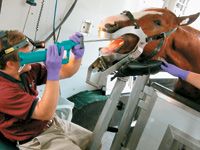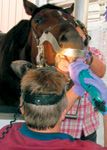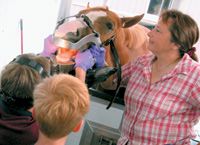Grow revenue, loyalty, horse health with routine dental examinations
Does every horse that you see undergo a dental exam? Is a complete oral exam including the use of sedation, a full-mouth speculum, a good headlight and a dental mirror part of your yearly preventative maintenance program? Do you include a complete oral exam as a part of all your pre-purchase exams? If you answered "Yes" to these questions, then you are, unfortunately, in the minority of equine practitioners today.
Does every horse that you see undergo a dental exam? Is a complete oral exam including the use of sedation, a full-mouth speculum, a good headlight and a dental mirror part of your yearly preventative maintenance program? Do you include a complete oral exam as a part of all your pre-purchase exams? If you answered "Yes" to these questions, then you are, unfortunately, in the minority of equine practitioners today.
Many equine veterinarians are missing out on the satisfaction of greatly helping the horse by increasing comfort, improving performance, enhancing the longevity of useful teeth, educating clients and expanding the quality of practice provided by a good dentistry service. As the primary healthcare provider, you are obligated to do a thorough oral exam, diagnose any problems and develop a plan for treatment.

Dr. Tom Johnson uses a power instrument to float a patient's teeth. Improper use of power equipment can lead to irreversible damage to the dentition.
Good dental care is an important part of a preventive maintenance program. Every horse in your practice should be a dental patient. Many horses show no outward signs of dental problems until the condition has progressed beyond complete repair. Simple, cursory dental exams (no sedation, light, speculum, etc.) miss a great deal and always should be suspect. Many educated owners no longer will accept a glance in the mouth of their horse and a "looks fine to me" from you. So schedule enough time to give their horse(s) a thorough dental exam. Purchase the equipment needed to do a proper exam safely. Sedate the horse adequately, and furnish proper assistance. Charge accordingly for the time, effort and education you have put into dentistry. Remember to think about the whole horse: a heart condition or COPD might need evaluation prior to a dental exam. Large non-healing oral ulcers and severe periodontal disease may indicate a metabolic condition, such as Cushing's disease.

DVM: Newsbreak
Pre-purchase exams are intended to give the prospective owner an idea of a horse's pre-existing conditions, how these conditions might affect the horse in the future and the likely maintenance of such problems.
Dental conditions, such as malocclusions, damaged or missing teeth, periodontal disease, bone spurs or other previous bit damage, etc. should be identified for the potential buyer. A horse that is suffering from untreated dental disease will be a frustration to the new owner just as a horse with a chronic lameness found on a pre-purchase exam.
Getting started
On the other hand, if you don't have the time, money, personnel or will to perform proper dentistry, then you have several options. Refer complicated cases to someone who enjoys dentistry and you feel does a responsible job. Take a few moments out of your busy schedule and spend some time with this person; allow them to show you what they feel the future dental care of the patient should be. Do the follow-up care and maintenance on these horses. Hire a new graduate who has an interest in dentistry, and provide additional training opportunities. By realizing that each horse in your practice is a potential dental patient, you can take your overly busy 1.5-person practice to a busy 2-person practice. By hiring a new graduate and paying them on a percentage basis in our practice, we were able to provide a very good wage and provide our clientele with a much better service than we would have with a well-trained veterinarian. Provide additional training opportunities for your technical help and delegate maintenance or follow-up work to them. Seek additional training yourself from dentistry wet labs and short courses and ride with a dental specialist; it may be the spark you needed to get you more involved in the rewarding field of equine dentistry.

Power floaters can overheat teeth and kill pulp, so practitioners must be attentive to the amount of tooth material removed, the amount of heat that an instrument can create and the longevity of the horses' dentition.
Your dental exam and subsequent treatment should be systematic, following a pattern that is comfortable for you and that ensures that all areas of the mouth are examined, treated and evaluated for function following treatment. Before sedating the horse, palpate structures of the head and poll for sensitivity. While the horse is becoming sedate, examine the head for any asymmetry, swellings, muscle atrophy and TMJ pathology. Palpate the upper and lower interdental space (bars) to check for the presence of wolf teeth, blind wolf teeth, unerupted canine teeth and bone spurs. Place a speculum in the horses' mouth and note the location of feed material before rinsing the mouth. Use a bright light source and a large, sturdy dental mirror to examine each arcade and quadrant of the mouth. The teeth should be observed for fractures, decay, excessive wear from opposing overgrowths, rotation or misalignment, and diastema, or spaces between the teeth.
Gums, cheeks, tongue and palate should be checked for ulcers, foreign objects, scar tissue, tumors and periodontal disease. Digital palpation should include checking each tooth for looseness, and palpating the soft tissues for ulcers, scars and periodontal disease. A foul odor can indicate pocketing of feed, retained deciduous teeth, periodontal disease or the presence of infection. Make any notations on the horses' dental record, and proceed with treatment using the same pattern used in your exam. Following the removal of the speculum, check your work with the mouth closed using a cheek retractor. Move the lower jaw laterally to bring the cheek teeth into occlusion and evaluate your work. Observe the incisors for the same pathologies as the premolars and molars. Perform incisor reductions with the same caution and accuracy given to the premolars and molars. In most cases if the cheek-tooth work is performed accurately, reducing only the overgrowths, very little incisor reduction should be necessary.

Dental exams should include checks for fractures, decay, excessive wear from opposing overgrowths, rotation, misalignment and diastema; gums, cheeks, tongue and palate should be examined for ulcers, foreign objects, scar tissue, tumors and periodontal disease.
The right stuff
Many severe dental disorders in mature horses would have never existed had there been proper care early in that horse's life. Diagnose and correct problems early. To that end, equip yourself properly. A single instrument or tool cannot access all areas of the mouth. The instruments that you use should be accurate, easy for you to manipulate and cause little soft-tissue trauma. The equipment that you use should be water-cooled and have sharp burs, disks or blades to keep heat production to a minimum. Your equipment should be easy for you to use and should not cause injury to the operator.
Keep your equipment up to date; how long did it take your present set-up to pay for itself? Invest in newer equipment that is safer for the horse and easier for the operator. Two practices that solicited my advice regarding equipment updates reported that in the year following the investment in new equipment, dental revenue rose tenfold, from $5,000 to $50,000! The veterinarians in these practices did much better work, were excited about the dentistry they performed, and their clients were appreciative of the positive change in their horses.
Live to float another day
It is important to realize that improper use of power equipment can lead to irreversible damage to the dentition quickly. Recent studies have illustrated the amount of heat produced by some power instruments commonly in use. Research at the Royal Dick School of Veterinary Studies at the University of Edinburgh, Scotland, has shown the equine tooth to be a living structure, more delicate in nature than previously believed.
Through EM and CT scans of the tooth, Dr. Paddy Dixon and Dr. Ian Dacre have mapped out the complexities of the live pulp cavities of the tooth and shown their susceptibility to damage. Their research also has shown that below a relatively thin layer of non-vital (sclerotic) dentin are tubules containing live projections from the odontoblast cells that deposit dentin.
Dr. Sue Kempson, also at Edinburgh, has shown through EM that peripheral cementum on the exposed crown of the tooth contains small blood vessels and nerves. In short: the equine tooth is a much more sensitive living structure than many of us once realized. It is not simply a block of wood that we may shape at will. It is normal for a horse to have sharp enamel edges to properly masticate coarse feed materials. Transverse ridges on the occlusal surface of the teeth are normal structures providing increased surface area and have a function in normal mastication. The curvature of the jaw (Spee's curve) is natural and should not be mistaken for a high lower caudal molar. Molar table angles vary naturally between individuals and should not be changed just to fit a mold of "the perfect mouth". While balance in the mouth is extremely important, a perfectly smooth, level mouth often will not be the most functional for the horse.
One must be conscious at all times of the amount of tooth material that is removed, the amount of heat that an instrument may create, as well as the longevity of the horses' dentition. It is not acceptable to create a "perfect" bite on a horse in one session and expose sensitive dentin, causing dysphagia for several days or even weeks.
It is not acceptable to remove too much tooth material at one time, creating enough heat to destroy the sensitive pulp and result in a dead or abscessed tooth in three or four years. These are problems that currently are being observed with the improper use of power instruments.
So, what can you do to prevent these complications?
- Use water-cooled instruments.
- Be accurate. Reduce only the overgrowths and leave normal tooth structures alone.
- Reduce large overgrowths in stages. Take down a portion of the overgrowth, finish work in other areas of the mouth, then after many minutes, return to reduce more of the large overgrowth.
- Realize that in the best interest of the horse and its health, a large overgrowth does not have to be corrected all at one time. A malocclusion this severe most often took years to form, and it should be corrected over many visits spanning months to years. A 2-cm overgrowth that is reduced 0.5 or 1 cm likely will be out of occlusion and no longer cause an obstruction of lateral excursion. By partially reducing the overgrowth, you will provide the horse improved lateral excursion and the ability to better use his mouth. The excessively worn opposing tooth will begin to recover, and the odontoblasts will deposit additional secondary dentin allowing for more non-sensitive tooth material to be removed at another time.
Finally, a complete record of your findings and treatments on a dental form provides a good medical/legal record and helps in itemization of all the work performed.
Dr. Johnson is owner of Advanced Equine Dentistry in Grass Lake, Mich. He graduated from Michigan State University in 1991 and has limited his practice to equine dentistry since 1994. Dr. Johnson is an adjunct associate professor at Michigan State University, and he lectures and teaches advanced dentistry courses internationally. He can be reached at (517) 522-4111 or via e-mail johns910@msu.edu.